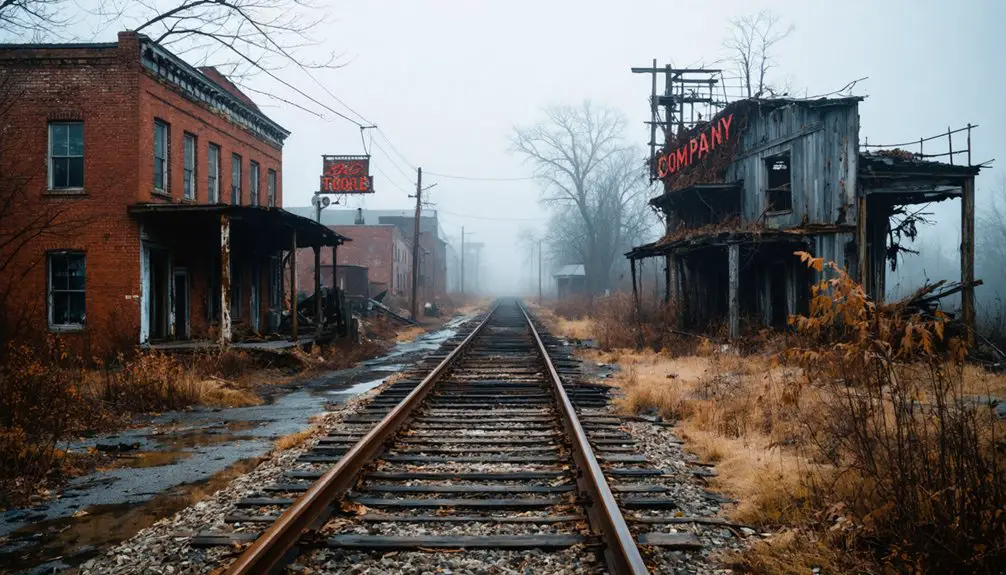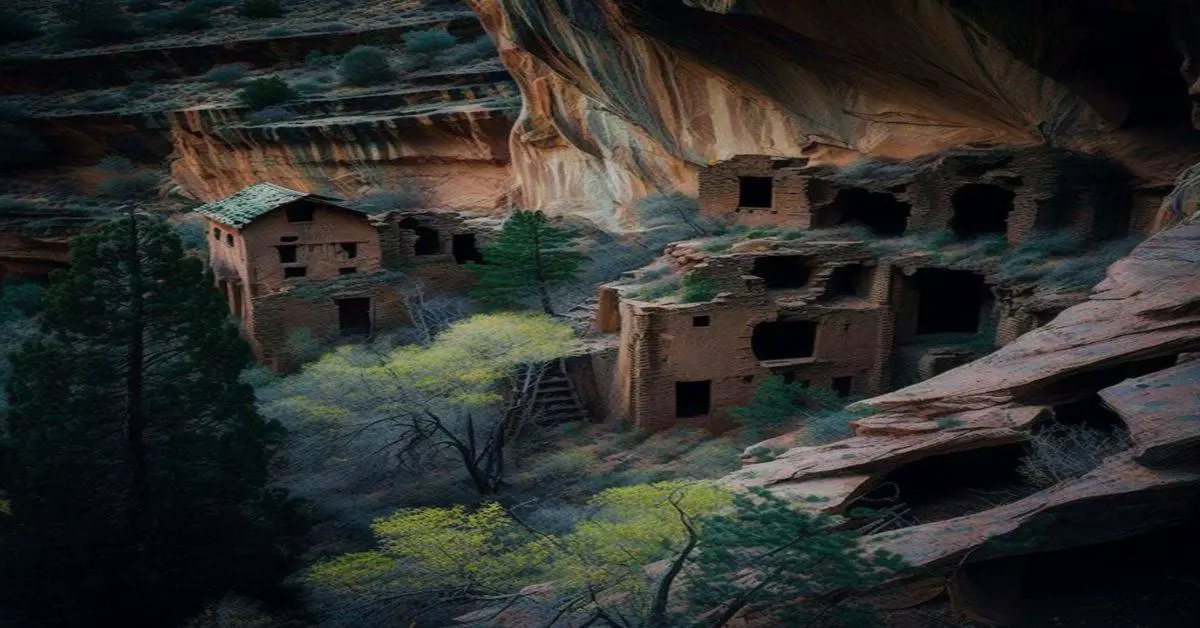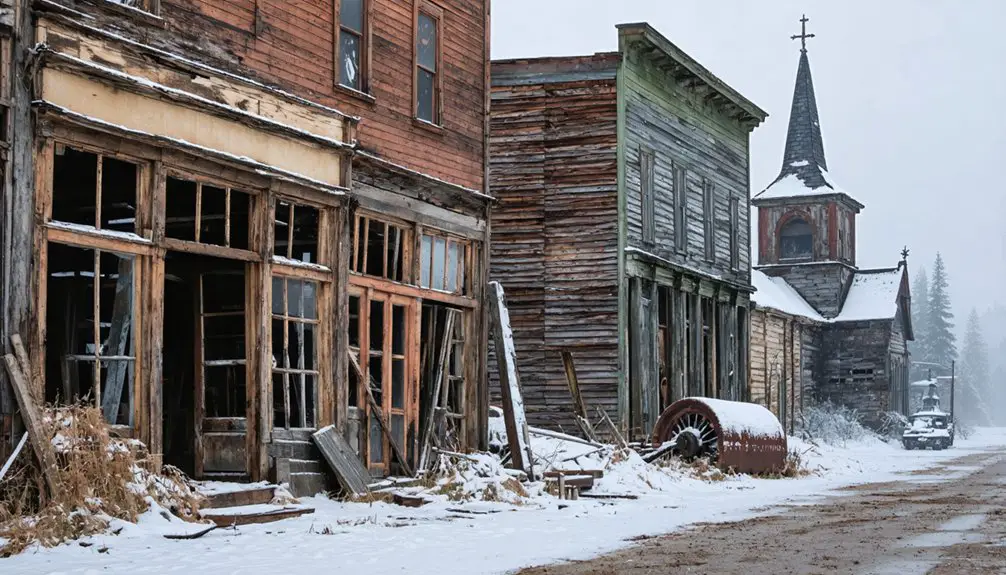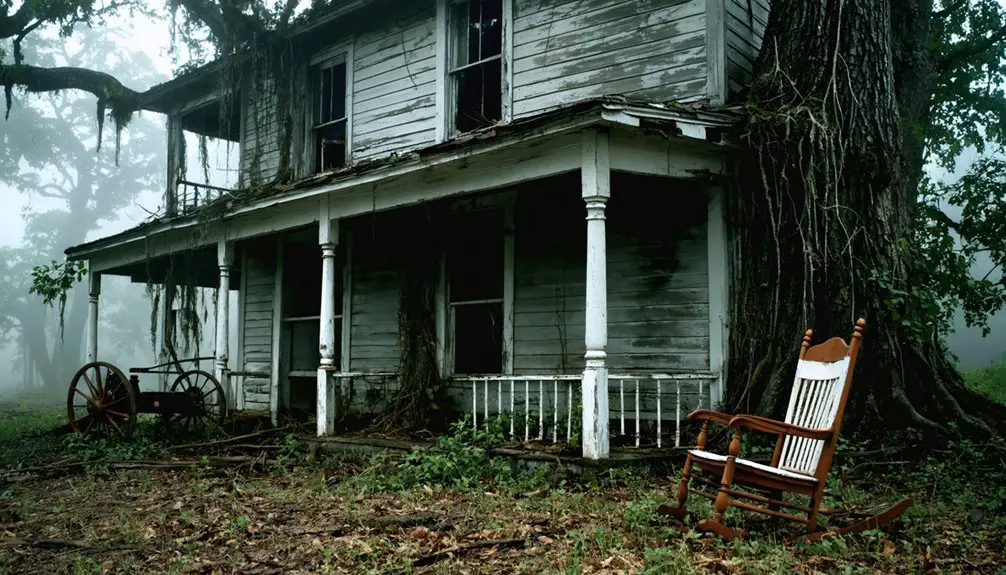You’ll find Fire Creek’s ruins along West Virginia’s New River Gorge, where this once-bustling coal town operated from 1873 to 1945. The site features distinctive brick foundations and a 150-yard stretch of coke ovens, setting it apart from typical wooden coal camps. Founded by Joseph L. Beury, Fire Creek became known for its early labor organization, particularly during the 1880 gorge-wide strike. The brick ruins and weathered industrial remains hold fascinating stories of America’s coal heritage.
Key Takeaways
- Fire Creek was a thriving coal mining town established in 1873 with the arrival of the Chesapeake & Ohio Railroad.
- The town featured distinctive brick architecture, including homes and community buildings, setting it apart from typical wooden coal camps.
- Economic decline began after World War II, leading to the closure of Fire Creek Coal and Coke Company in 1945.
- Extensive ruins of brick foundations and a 150-yard stretch of historic coke ovens remain along New River Gorge trails.
- The site is now protected as part of the National Park system, preserving its coal mining heritage for visitors.
The Rise of a Coal Mining Empire
When the Chesapeake & Ohio Railroad arrived in 1873, Fire Creek emerged as one of New River Gorge’s pioneering coal camps, marking the beginning of West Virginia’s industrial transformation.
You’ll find that Fire Creek’s early adoption of coal processing technology, particularly its coke ovens, set it apart from other mining settlements. The town’s growth paralleled the region’s explosive industrial development, as coal production soared from under 1 million tons pre-1880 to 5 million tons by 1887.
While small crews of just 80 men initially worked the mines at 45 cents per ton, Fire Creek’s strategic rail access helped transform local coal into a valuable export commodity. Founded by Joseph L. Beury, the camp quickly established itself as a model for industrial development in the region.
Fire Creek’s railroad connection turned small-scale mining operations into a major economic force, with crews pioneering the region’s coal exports.
The town’s brick construction, unusual for coal camps, reflected the permanence and prosperity that mining brought to this corner of West Virginia. Workers received their wages in company scrip which could only be used at the company-owned store.
Brick Buildings and Community Life
Fire Creek’s distinctive brick architecture set it apart from the wooden structures that dominated most New River Gorge coal towns.
You’ll find the remains of carefully planned brick homes and community buildings that fostered strong community cohesion among residents, creating a more permanent settlement than typical coal camps.
- Brick foundations and partial walls still peek through natural overgrowth
- Homes connected seamlessly to essential facilities like company stores
- Community buildings hosted social gatherings and labor organization meetings
- Coke ovens were strategically positioned behind brick structures
- Post office and railway station anchored town life until 1947
Walking along the old retaining wall, visitors can trace the path leading to the historic coke ovens that stretch roughly 200 yards along Fire Creek.
Like in Kaymore, the area has been slowly reclaimed by thick forest vines that wrap around the remaining structures.
The brick buildings’ durability reflected Fire Creek’s ambitious vision, though they couldn’t prevent the town’s eventual abandonment as coal’s dominance waned.
Today, these weathered foundations stand as evidence of a once-thriving community‘s resilience and independence.
Labor Strikes and Social Changes
As labor unrest spread across West Virginia’s coalfields in the late 1800s, Fire Creek emerged as an early epicenter of worker organization.
You’ll find Fire Creek’s labor history beginning with the Knights of Labor in 1879, when workers formed one of the area’s first local assemblies. They demonstrated remarkable worker solidarity during the 1880 gorge-wide strike, even commandeering a C&O train to rally support from Hawks Nest miners.
Fire Creek’s legacy of resistance continued into the 1890s, though labor repression intensified. The miners often wore red bandanas during protests, establishing a tradition that would continue for decades to come. The coal companies maintained company towns where they controlled housing, schools, and stores in a feudal-like system.
When residents joined the UMWA’s 1894 strike, they faced the same fierce opposition that would later explode during the Paint Creek-Cabin Creek strikes and the Battle of Blair Mountain.
These struggles permanently shaped Fire Creek’s community identity, despite the eventual decline of union power.
Post-War Economic Decline
Following World War II, you’d witness a dramatic transformation in Fire Creek’s economic landscape, driven by plummeting coal demand and technological shifts in American industry.
The town’s economic shifts became starkly apparent as diesel locomotives replaced coal-powered engines and automation reduced mining jobs. The introduction of continuous mining machines in the 1970s further eliminated the need for human labor. Despite community resilience, Fire Creek couldn’t survive the perfect storm of resource depletion and industrial changes. Like many communities facing similar challenges, Fire Creek residents experienced rising cases of black lung disease among former miners.
- The Fire Creek Coal and Coke Company sold its facilities in 1945
- Post office closure in 1947 signaled the town’s declining fortunes
- Railroad depot demolition in 1957 further isolated the community
- Technological advances in mining reduced labor needs dramatically
- By the 1970s, nature had reclaimed much of the abandoned town
These changes mirrored broader regional trends, as Fire Creek joined countless other Appalachian communities facing similar fates in the postwar era.
Exploring the Ruins Today
Today, intrepid explorers can discover Fire Creek’s haunting remnants along the New River Gorge‘s winding trails in Fayette County, West Virginia. You’ll find extensive ruins of brick foundations and a remarkable 150-yard stretch of historic coke ovens, though nature’s reclaiming much of the site. Similar to Nuttallburg’s suspension bridge, Fire Creek features ruins that highlight the region’s industrial heritage. Due to multiple locations sharing the name, visitors should verify they’re heading to the Fire Creek disambiguation site in West Virginia.
For safe exploration, you’ll need sturdy hiking boots and careful attention to your surroundings. The unmaintained terrain presents challenges with unstable structures and uneven ground.
While ruin preservation efforts are minimal, the site’s inclusion in the National Park helps protect these valuable historic resources. You can explore foundations where miners’ homes once stood and photograph remnants of the industrial complex that powered this early coal camp.
The site offers a raw, unfiltered glimpse into Appalachia’s coal mining heritage.
Frequently Asked Questions
What Indigenous Peoples Inhabited the Fire Creek Area Before Coal Mining Began?
You’d find Native tribes like the Mound Builders, Fort Ancient farmers, Calicua, and Cherokee in this area, with cultural practices including burial mound construction, corn farming, and seasonal hunting.
How Did Weather and Flooding Impact Daily Operations in Fire Creek?
Like a relentless hammer, flood damage and harsh weather patterns pounded your daily mining operations, wreaking havoc on rail lines, disrupting coal processing, and forcing frequent shutdowns of coke ovens.
What Were the Most Common Diseases and Medical Conditions in Fire Creek?
You’d find tuberculosis outbreaks spreading through cramped miners’ quarters, while black lung disease, mining injuries, and respiratory infections plagued workers. Poor sanitation led to widespread dysentery and cholera.
Where Did Fire Creek Residents Get Their Drinking Water Supply?
You’d have found your water sources from nearby springs, creeks, and rainwater catchment systems. With no municipal infrastructure, you’re collecting directly from nature, which affected your community health.
What Happened to the Cemetery and Burial Grounds After Abandonment?
You’ll find these burial grounds largely forgotten, with minimal cemetery preservation efforts. Nature’s reclaimed the sites – they’re overgrown, markers are eroding, and only occasional discoveries by hikers reveal their historic presence.
References
- https://theclio.com/entry/136112
- https://www.youtube.com/watch?v=-EeLwLa2t90
- https://wvhistoryonview.org/catalog/052122
- https://en.wikipedia.org/wiki/Fire_Creek
- https://theclio.com/tour/1943
- https://www.nps.gov/neri/learn/historyculture/royal.htm
- https://minesafety.wv.gov/historical-statistical-data/mining-in-west-virginia-a-capsule-history/
- https://www.legendsofamerica.com/west-virginia-coal-mining/
- https://coalheritage.wv.gov/coal_history/Pages/Birth-of-the-Industry.aspx
- https://www.youtube.com/watch?v=ejkrDYEMRj8



